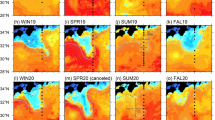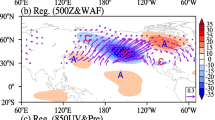Abstract
NCEP/NCAR reanalysis data and a 47-year precipitation dataset are utilized to analyze the relationship between an atmospheric heat source (hereafter called 〈 Q 1 〉) over the Qinghai-Xizang Plateau (QXP) and its surrounding area and precipitation in northwest China. Our main conclusions are as follows: (1) The horizontal distribution of 〈 Q 1 〉 and its changing trend are dramatic over QXP in the summer. There are three strong centers of 〈 Q 1 〉 over the south side of QXP with obvious differences in the amount of yearly precipitation and the number of heat sinks predominate in the arid and semi-arid regions of northwest China (NWC), beside the northern QXP with an obvious higher intensity in years with less precipitation. (2) In the summer, the variation of the heat source’s vertical structure is obviously different between greater and lesser precipitation years in eastern northwest China (ENWC). The narrow heat sink belt forms between the northeast QXP and the southwestern part of Lake Baikal. In July and August of greater precipitation years, the heating center of the eastern QXP stays nearly over 35°N, and at 400 hPa of the eastern QXP, the strong upward motion of the heating center constructs a closed secondary vertical circulation cell over the northeast QXP (40°-46°N), which is propitious to add precipitation over the ENWC. Otherwise, the heating center shifts to the south of 30°N and disappears in July and August of lesser precipitation years, an opposite secondary circulation cell forms over the northeast QXP, which is a disadvantage for precipitation. Meanwhile, the secondary circulation cell in years with more or less precipitation over the ENWC is also related to the heat source over the Lake Baikal. (3) The vertical structure of the heat source over the western QXP has obvious differences between greater and lesser precipitation years in western northwest China in June and July. The strong/weak heat source over the western QXP produces relatively strong/weak ascending motion and correspondingly constructs a secondary circulation cell in lesser/greater precipitation years.
Similar content being viewed by others
References
Chen, L. X., and W. L. Li, 1982: The structure of monthly atmosphere heat sources over the Asian monsoon region. Proceedings of National Seminar on Tropical Summer Monsoon, Yunnan People’s Publishing House, Kunming, 246–255. (in Chinese)
Duan, A. M., and G. X. Wu, 2003: The main spatial heating patterns over the Tibetan Plateau in July and the corresponding distributions of circulation and precipitation over eastern Asia. Acta Meteorologica Sinica, 61(4), 447–455. (in Chinese)
Duan, A. M., Y. M. Liu, and G. X. Wu, 2005: Heating status of the Tibetan Plateau from April to June and rainfall and atmospheric circulation anomaly over East Asia in midsummer. Science in China (D), 48(2), 250–257.
Flohn, H., 1957: Large-scale aspects of the “summer monsoon” in South and East Asia. J. Meteor. Soc. Japan, 75, 180–188.
He, H. Y., J. W. McGinnis, Z. S. Song, and M. Yanai, 1987: Onset of the Asian Summer Monsoon in 1979 and the effect of the Tibet Plateau. Mon. Wea. Rev., 115, 1966–1995.
Huang, Y. X., D. L. Li, and B. J. Wang, 2004: Analysis on temporal-spatial features of annual precipitation in North west China in 1961–2000. Plateau Meteorology, 23(2), 245–252. (in Chinese)
Jian, M. Q., and H. B. Luo, 2002: Daily Variation of Heat Sources over the eastern Qinghai-xizang Plateau (QXP) and surrounding areas and their relationship to the circulation over the Tibetan Plateau. Plateau Meteorology, 21(1), 25–30. (in Chinese)
Liu, Y. M, J. C. L. Chan, J. Y. Mao, and G. X. Wu, 2002: The role of Bay of Bengal convection in the onset of the 1998 South China Sea Summer Monsoon. Mon. Wea. Rev., 130, 2731–2744.
Liu, Y. M., B. J. Hoskins, and M. Blackburn, 2007: Impact of Tibetan orography and heating on the summer flow over Asia. J. Meteor. Soc. Japan, 85B, 1–19.
Ma, Z. G. and C. B. Fu, 2006: Some evidence of drying trend over northern China from 1951 to 2004. Chinese Science Bulletin, 51(23), 2913–2925.
Ma, Y., H. Ishikawa, O. Tsukamoto, M. Menenti, Z. Su, T. Yao, T. Koike, and T. Yasunari, 2003: Regionalization of surface fluxes over heterogeneous landscape of the Tibetan Plateau by using satellite remote sensing. J. Meteor. Soc. Japan., 81, 277–293.
Ma, Z. G., C. B. Fu, and L. Dan, 2005: Decadal variations of arid and semi-arid boundary in China. Chinese Journal of Geophysics, 48(3), 575–581.
Qian, Z. A., T. W. Wu., and X. Y. Liao, 2001: Feature of mean vertical circulation over the Qinghai-xizang Plateau (QXP) and its neighborhood. Chinese J. Atmos. Sci., 25(4), 444–454. (in Chinese)
Shi, Y. F., Y. P. Shen, and R. J. Hu, 2002: Preliminary study on singal, impact and foreground of climate shift from warm-dry to warm-wet in Northwest China. Journal of Glaciology and Geocryology, 24(3), 219–226. (in Chinese)
Song, L. C., and C. J. Zhang, 2003: Changing feature of precipitation over Northwest China during the 20th century. Journal of Glaciology and Geocryology, 25(2), 143–148. (in Chinese)
Sun, W. L., 1997: Heating status of the Tibetan Plateau and the spring rainfall in eastern Qinghai province. Analysis on Aridity Climate in Northwest of China. China Meteorological Press, Beijing, 278–281. (in Chinese)
Wang, B. J., Y. X. Huang, and J. H. He., 2004: Relation between vapour transportation in the period of East Asia summer monsoon and drought in Northwest China. Plateau Meteorology, 23(6), 912–918. (in Chinese)
Wang, C. H., A. X. Dong, D. B. Yang, and S. G. Wang, 2000: The correlation between precipitation in Northwest China during spring and snow depth in the Tibetan Plateau. Journal of Glaciology and Geocryology, 22(4), 340–346. (in Chinese)
Wang, Y. Q., L. S. Chen, and Z. X. Luo, 2002: Numerical simulation of effect Qinghai-Xizang Plateau on drought in Northwest China. Plateau Meteorology, 21(6), 529–535. (in Chinese)
Wu, T. W., and Z. A. Qian, 1996: The comparative analyses of differences between vertical circulation on north side of Tibetan Plateau in wet and dry summer and thermal effects of the Plateau. Acta Meteorologica Sinica, 54(5), 558–568. (in Chinese)
Wu, T. W., Z. A. Qian, and P. J. Li, 1998: Some comparative analyses of precipitation over Northwest China drought area after the Qinghai-Xizang Plateau heavy and light snow years. Plateau Meteorology, 17(4), 364–372. (in Chinese)
Yanai, M., S. Esbensen, and J.-H. Chu, 1973: Determination of bulk properties of tropical cloud clusters from large-scale heat and moisture budgets. J. Atmos. Sci., 30, 611–627.
Yeh, T. C., 1988: The thermal structure and the convective activity over Qinghai-Tibetan Plateau in summer and their interactions with large-scale circulation. Scienia Atmospheric Sinica (Special Issue), 1–12. (in Chinese)
Yeh, T. C., S. W. Luo, and B. Z. Zhu, 1957: The wind structure and heat balance in the lower troposphere over Tibetan plateau and its surrounding. Acta Meteorologica Sinica, 28, 108–121. (in Chinese)
Zhang, C. J., J. N. Xie, and D. L. Li, 2002: Effect of East-Asia monsoon on drought climate of Northwest China. Plateau Meteorology, 21(3), 193–198. (in Chinese)
Zhao, P., and L. X. Chen, 2001: Climatic features atmospheric heat source/sink over Qinghai-Xizang Plateau in 35 years and its relation to rainfall in China. Science in China (D), 44(9), 858–864.
Zhao, S. R., Z. S. Song, and L. R. Ji, 2003: Heating effect of the Tibetan Plateau on rainfall anomalies over north China during rainy season. Chinese Journal of Atmospheric Science, 27(5), 881–893. (in Chinese)
Zhu, Q. G., C. Y. Sheng, and M. Chen, 2000: Winter Tibet plateau OLR inter-annual variational features and the relation to China summer rainfall. Plateau Meteorology, 19(1), 75–82. (in Chinese)
Author information
Authors and Affiliations
Corresponding author
Rights and permissions
About this article
Cite this article
Wei, N., Gong, Y. & He, J. Structural variation of an atmospheric heat source over the Qinghai-Xizang Plateau and its influence on precipitation in northwest China. Adv. Atmos. Sci. 26, 1027–1041 (2009). https://doi.org/10.1007/s00376-009-7207-7
Received:
Revised:
Published:
Issue Date:
DOI: https://doi.org/10.1007/s00376-009-7207-7




